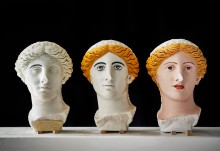In 1980, endowed with a grant from the German Academic Exchange Service, I began investigating the coloration of ancient marble sculptures in Athens. When we open the expanded version of the exhibition “Gods in Color” at the Frankfurt Liebieghaus in January, I personally will be looking back on forty years of research into so-called statuary polychromy. I find that amazing! And I’m also surprised by the fact that, since 2003, the “Gods in Color” have been on view in thirty venues all over the world—and that we’ve pursued this project with unbroken effort and ambition. Is this just passion—or is it already obsession?
In 1984 Ulrike Koch, later Koch-Brinkmann, joined the very active team that had gathered around our teacher, Professor Volkmar von Graeve, with the aim of studying the phenomena of color in Greek and Roman antiquity. For his doctorate, which he earned at Frankfurt’s Goethe University, von Graeve himself had researched the vivid coloration of the sculptures on the so-called Alexander Sarcophagus in Istanbul, and within that context developed new investigation methods in collaboration with his fellow Frankfurt student Hans Christof Wolters.
While I applied myself to optimizing the possibilities of so-called multispectral photography, Ulrike Koch began studying ancient painting and, with the aid of the drawing medium, evaluating the results of our new investigations. The German Research Foundation provided substantial financial support to both of these endeavors from as far back as 1982 onward.
Later, around the mid-’80s, several of our fellow scientists began to advocate visualizing the abundance of new findings in reconstructions on casts—both to benefit research and to enlighten the public.
We finally gave in to this pressure in 1990—that is, thirty years ago—and, with the support of colleagues at the Glyptothek in Munich, began our first reconstruction: Variant A of the polychromy of the archer from the west pediment of the Temple of Aphaia on an artificial marble cast. This project presented Ulrike Koch, and all of us, with unforeseen challenges, particularly because we had resolved to work solely with authentic natural painting materials. What is more, however, the replication of the complex ornamentation required a reconstruction of the mathematical-geometric construction aids used in antiquity.
The outcome, however, was astounding, and shook our traditional image of antiquity to the core. When the Frankfurter Allgemeine Zeitung published an illustration of this reconstruction for the first time in 2001—in black and white!—the readers were highly indignant about the vivid colors.
Our team meanwhile looks back on more than a hundred research campaigns that have taken us and our analysis devices to all of the world’s relevant collections. Nor of course did we limit ourselves to just that one reconstruction. Including the eight new reconstructions we carried out—with support from the German Federal Ministry of Education and Research—especially for the “Golden Edition”, the team around Ulrike Koch-Brinkmann has painted some 60 copies of ancient marble and bronze sculptures in color.
The copies themselves are made of various materials, for example plaster, artificial marble, marble and polymethyl methacrylate, but also bronze and copper. In cases of copies of marble originals, we first coat them with stucco marble before applying the original natural pigments and binding agents.
Every single reconstruction project has proven fundamentally significant to our research. It is not until one is confronted with the task—in a sense the quite merciless task—of formulating an answer to every area of a sculpture’s surface that one is forced to address a comprehensive catalog of questions to the surviving traces on the original and related monuments.
Polychromy research
Learn more about polychromy research at the Liebieghaus here.
We could lean back and enjoy our success—at the exhibition in San Francisco in the winter of 2017/2018, for example, as many as 6,000 visitors came to see the “Gods in Color” on a single day—if not for the fact that we are subjected to (sometimes unobjective) criticism. Naturally, in the effort to shed light on past times, historical research can develop no more than approximations or models. The same applies to our field: the academic discipline of classical archaeology. Science is therefore always called on to produce different models and allow them to enter into competition with one another. That is equally true of research into statuary polychromy. Over the decades we have therefore developed alternative models, also taking other colleagues’ findings into account. In the future, further proposals from yet other quarters are sure to join the existing ones. Precisely if we practice this form of discursive study and collaboration, every new approach will take us a step further.
There’s no question about it: ancient sculpture was colorful. And the team at the Liebieghaus Skulpturensammlung has contributed significantly to gaining a more precise conception of that colorful sculpture. There’s also no doubt about something else: in the nineteenth century and up until World War I, both scholars and the public knew that the ancient world was full of color. It was only through the new aesthetic that came to prevail in the first half of the twentieth century (nota bene: not the Bauhaus) that polychromy was suppressed—and only through the students around Volkmar von Graeve in Frankfurt and his later pupils that it has been revived.












